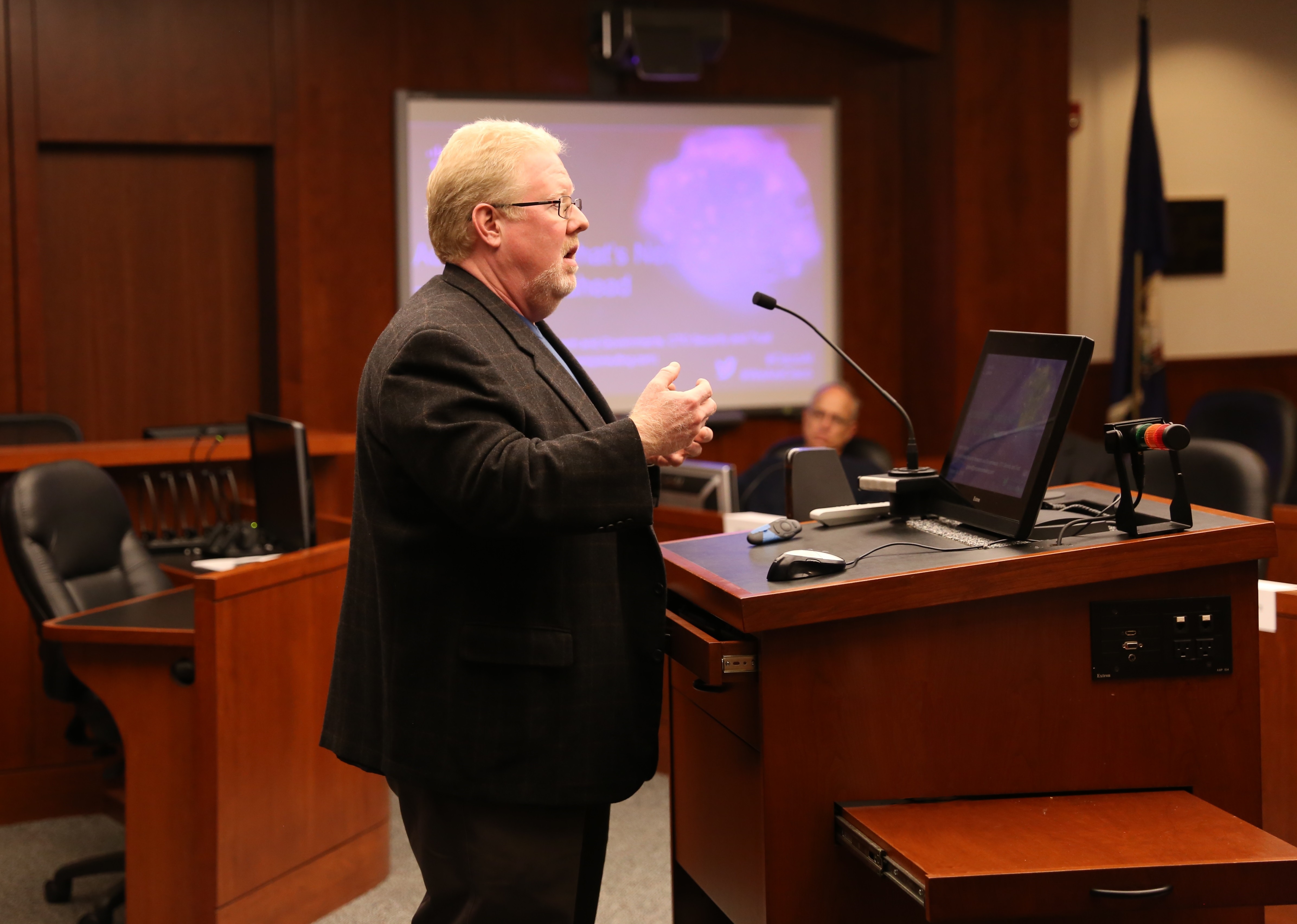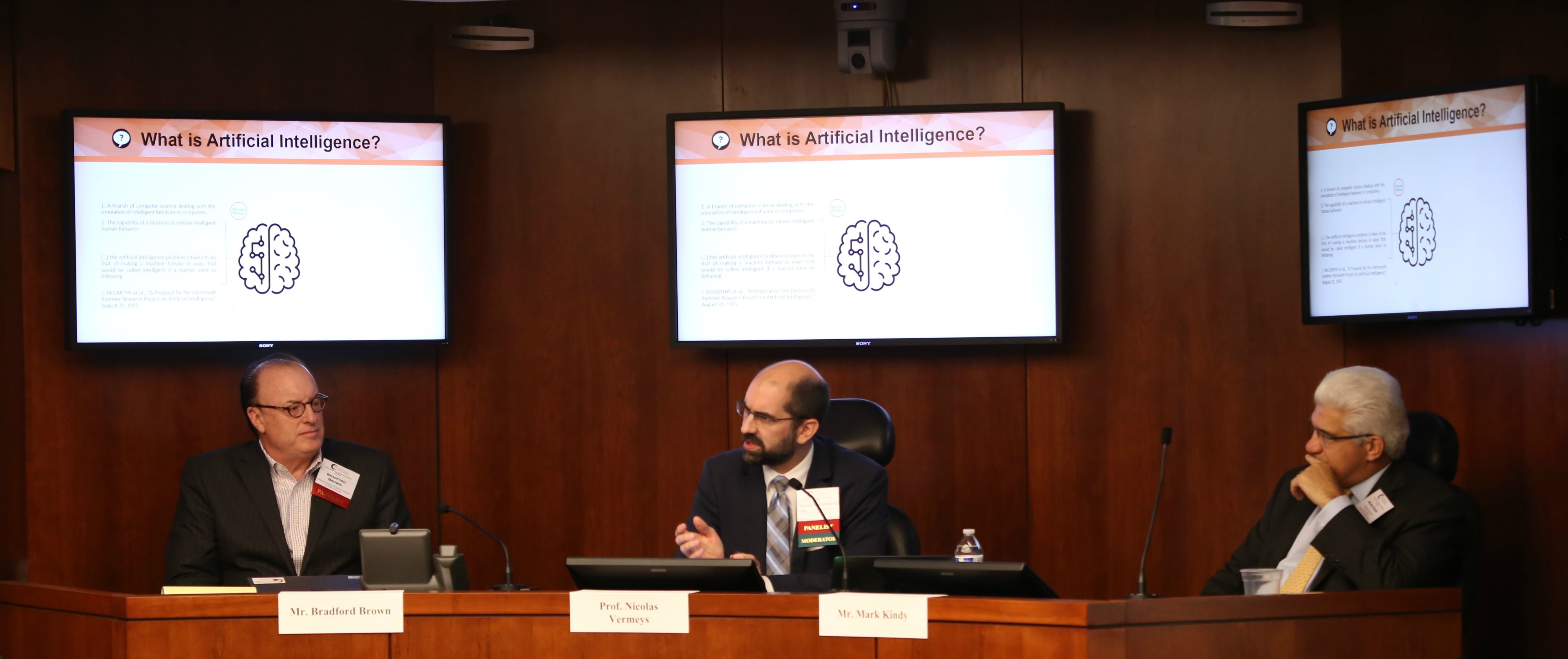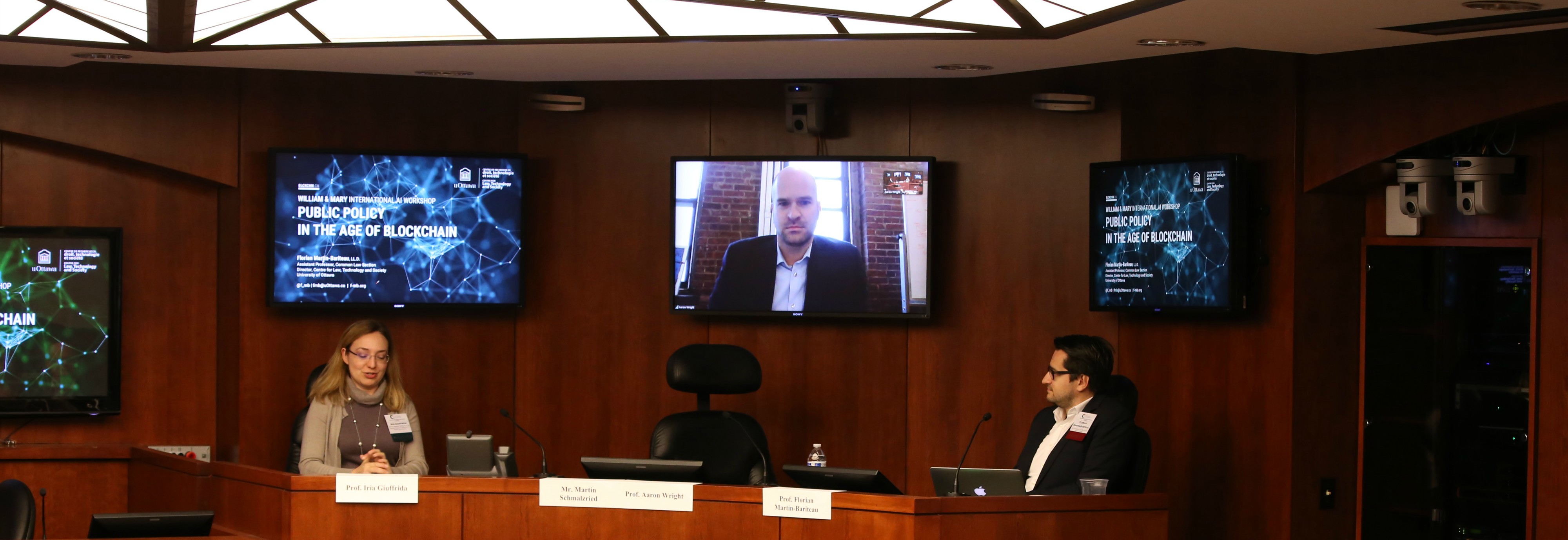
2018 International Workshop
CLCT was pleased to host its inaugural 2018 International Workshop: Legal Issues Lurking Behind the Convergence of Artificial Intelligence (AI), Internet of Things (IoT), and Blockchain. The Workshop welcomed speakers representing legal, business, academic, policy, and technical perspectives from around the world–with speakers from the U.S., Canada, and Europe. The Workshop inspired dynamic discussion and thoughtful exchanges, reflecting on the interdisciplinary, multi-jurisdictional, and interconnected nature of these emerging technologies.
Held on Friday, October 26, 2018 and Saturday, October 27, 2018 in William and Mary Law School’s iconic McGlothlin Courtroom, the program featured a keynote speech, followed by three focused panels.
The full program for the 2018 International Workshop, including speaker bios, is available HERE.
Keynote Speech: “Looking Ahead” with Gregory Akers

Gregory Akers, Senior Vice President and Chief Technology Officer at Cisco Systems, Inc. (retired), led off the event with a keynote speech addressing the unique opportunities and challenges posed by technologies like artificial intelligence.
The speech began by examining the development of key technology terms, like AI, machine learning, and deep learning, distinguishing these terms while simultaneously illustrating their interrelated nature.
In doing so, the presentation illuminated the advantages of using machine learning compared to traditional, rules-based programming, especially when coding the rules would be too difficult, when looking for patterns or correlations in large data sets, or when working with multiple hypotheses or changing variables.
Akers’s presentation then moved on to demonstrate the ways in which AI, IoT, and blockchain combine to form an ever more nuanced, intricate system of technology interactions. Specifically, how IoT provides the data, AI provides the analysis, and blockchain provides the “rules of the road.” To further illustrate how these technologies will combine shape the future, and how these technologies are already at work doing so, Akers walked through examples of AI accelerating the transformation of major industries, like retail, healthcare, and transportation. These examples reinforced the major benefits of AI, IoT, and blockchain, but also led into the discussion of the legal issues emerging technologies present.
In conclusion, Akers’s attention turned to how AI, IoT, and blockchain combine to create an ever more complex world. Acknowledging that these technologies inevitably raise equally complicated questions of law and policy, Akers emphasized the importance of events like the 2018 International Workshop in discovering those legal questions embedded in the use of emerging technologies.
Panel 1: Big Data, Deep-Learning and AI, and the Law

Speakers: Bradford Brown, Mark Kindy, and Nicolas Vermeys
The first panel looked more closely at AI applications, examining both the use of AI within legal services and the legal challenges created by AI tools more broadly. To start, Mark Kindy, Managing Director at Alvarez & Marsal Disputes & Investigations, explored AI and machine learning as potential disruptors in the legal industry. Using the examples of eDiscovery and court reporting, Kindy discussed how, despite demonstrated cost-savings and increased accuracy, many law firms hesitate to adopt new technologies. Through his experience offering data analytics services to lawyers, Kindy noted this resistance to technologies is often the result of not understanding and therefore distrusting the technology; as a result, attorneys prefer to avoid the risk of using it altogether until better precedent is set for its use. He also noted, however, the trends toward increasing in-house presence, as well as law firms outsourcing to outside firms; Kindy suggested this may increase the range of technologies used as legal teams become more specialized. The presentation concluded emphasizing the potential for data analytics and AI to remarkably improve legal services, giving lawyers the ability to analyze litigation outcomes or firm spending patterns like never before.
Next to speak was Bradford Brown, Portfolio Director and Senior Advisor for the Center for Judicial Informatics, Science & Technology at the MITRE Corporation, who discussed his experience with AI tools for legal reasoning. Brown began by distinguishing decision-support AI tools, with which humans remain at the helm of decisions with assistance from AI, from autonomous decision making, whereby the AI decides and acts with the human “out of the loop.” Brown also reflected on the current state of AI in the legal profession, including outcome prediction tools and various startup projects in the field. To assess the impact of these tools in the legal field, Brown highlighted how AI has professional benefits—especially the ability to provide quality services with limited resources—but also challenges—including problems with fairness and bias, privacy, and algorithmic transparency (or AI as a “black box”). As AI is increasingly incorporated in legal services, he noted, it is important to understand the limitations and risks of the technology, incorporate incremental adoption, and define clear organization values. Brown concluded by predicting the rise of the “T Shaped Lawyer,” with deep legal knowledge and the ability to collaborate across disciplines, and by imagining the future of legal systems where humans, AI, and IT systems create a “dynamic court” that benefits from cognitive assistance.
The AI panel then heard from Nicolas Vermeys, Law Professor and Assistant Director of the Cyberjustice Laboratory at the University of Montreal. After working through definitions about the underlying technology, Vermeys discussed the advancements of AI within both the U.S. and Canadian legal systems. One application Vermeys highlighted was Online Dispute Resolution (ODR) platforms, where disputes can be referred for negotiation or mediation online without the intervention of a judge. Vermeys presented the potential of AI as a tool to increase autonomy of legal actors and enable them to make better decisions, rather than a way of replacing lawyers and judges. As the ODR example demonstrated, many cases can be resolved outside of the courts, increasing citizen satisfaction and freeing up court dockets for those disputes that cannot be independently resolved. Vermeys also emphasized the limitations of AI, such as the “black box” problem in which AI output cannot be explained, replicated, or understood, even by the algorithm’s creators, due to the complex nature of the algorithms. Vermeys then discussed how Canada is working to address this issue through the Directive on Automated Decision Making, which requires, in part, AI impact assessments, source code transparency, quality assurance and testing for bias and data quality, the right to appeal to a human decision-maker, and mandatory reporting of information and statistics.
Panel 2: Blockchain and the Law

Speakers: Florian Martin-Bariteau, Martin Schmalzried, and Aaron Wright
The workshop resumed Saturday morning with a panel on Blockchain and the Law, exploring both the practical challenges of blockchain—like security limitations and imprecise translation of legal terms into code—and the challenges and potential solutions for regulating blockchain technology.
First to speak on the Blockchain Panel was Aaron Wright, Associate Clinical Professor of Law and Director of the Tech Startup Clinic at Benjamin N. Cardozo School of Law, who appeared remotely. Wright set the stage, reviewing the characteristics of blockchain and the challenges posed to governments seeking to regulate blockchain. Namely, he described blockchain as peer-to-peer transactions that are transparent, pseudonymous, and tamper resistant, with the potential to be global, transnational, and resilient. Wright also illustrated the broad impact of blockchain with use cases from cryptocurrencies to smart contracts to information storing and sharing systems. While these characteristics create hurdles for traditional, territorial government regulation, Wright acknowledged that the technology is, fundamentally, capable of regulation through intermediaries. Blockchain does not exist in a vacuum, but often relies on traditionally regulated technologies and systems; instead of regulating blockchain directly, the existing governance of users or the internet, for example, will place some external controls on blockchain operation. Wright also discussed the concept of “code is law” to demonstrate that new rules related to social and commercial activity can be embedded into blockchain code. One example was the use of smart contracts to ensure compliance with this coded “law,” which will increase both accountability and transparency. This example also demonstrated how blockchain and other technologies combine to create new issues but also novel solutions to these legal challenges.
Martin Schmalzried, Policy and Advocacy Manager at Families Europe, also appeared remotely, joining the conference from Belgium and offering a perspective on blockchain and EU law. Schmalzried picked up the conversation about regulating blockchain, discussing the recent efforts of EU member states to regulate blockchain permissions. He also addressed the different regulatory challenges posed by private blockchains versus public blockchains, and by online, offline, and hybrid blockchains, providing examples of each type of blockchain. Schmalzried likewise cautioned against a knee jerk reaction to over-regulate blockchain, especially when attempts to regulate access to centralized exchanges could be easily circumvented or could drive the transactions underground. Schmalzried instead suggested the need for co-regulation and self-regulation to support a governance structure that consults coders and technologists when developing legal solutions. Additionally, he recommended that regulation be based on real use cases of blockchain, instead of speculating how the technology will work. As blockchain is difficult to change, Schmalzried argued preventative rules are preferable to legal “punishments,” re-emphasizing the need to “ask the hard questions upfront” about blockchain.
The final member of the Blockchain Panel was Florian Martin-Bariteau, Law Professor and Director of the Centre for Law, Technology and Society at the University of Ottawa, who began by weighing the pros and cons of blockchain from a public policy perspective. On the one hand, he assessed, blockchain enables social justice technologies, like dispute resolution, voting records, or data management. However, Martin-Bariteau advocated a cautious, critical approach to deciding whether and how to incorporate blockchain into workflows, or in deciding how to regulate blockchain. For instance, Martin-Bariteau cautioned against using blockchain as a one size fits all solution, emphasizing instead the objectives that blockchain best achieves: ledger, trust, security, and transparency. To demonstrate his argument, Matin-Bariteau worked through blockchain applications, like smart contracts, to show that, while blockchain solves some problems, it raises other issues—like professional ethics rules when contract drafting becomes technical coding, or how to code legal standards like “good faith” or “reasonableness.” Finally, Martin-Bariteau addressed the privacy considerations associated with blockchain’s transparency and immutability, especially in light of legal requirements like the right to data accuracy and erasure as encoded in the EU’s General Data Protection Regulation (GDPR). Given these challenges, Martin-Bartieau concluded by suggesting that perhaps the “old way” of drafting civil law with broad, short provisions is a better solution for governing these new technologies.
Panel 3: The Internet of Things and the Law

Speakers: Hillary Brill, Elena Carpanelli, Stacy-Ann Elvy, and Sofia Ranchordás
The final panel focused on the ever-expanding universe of data created by connected devices, known as the Internet of Things (IoT). From smart cities to wearable devices, this panel illustrated that the legal issues associated with IoT is as wide and various as the IoT applications themselves.
Stacy-Ann Elvy, Law Professor and Associate Director of the Center for Business and Financial Law at New York Law School, kicked off the panel, appearing remotely to survey the various legal questions arising from IoT devices. Elvy’s presentation focused on liability risks arising from the use of IoT, including potential liability under Article 2 of the Uniform Commercial Code (UCC), products liability, and UCC Article 9 liability. Elvy examined the present capacity of these liability rules to address the unique nature of IoT devices, such as whether Article 2—governing the sale of goods—can sufficiently cover IoT device software services, or whether gaps in regulation remain. To punctuate this point, she explored how creators and sellers of IoT devices maintain post-transaction control and provide continuing service to the IoT devices; when the service to the device ends, the device loses functionality, causing loss for consumers. Similarly, as these companies provide services, they collect consumer data and obtain valuable insights. Elvy concluded noting that the nature of these devices raise important legal questions related to the creation of device privacy policies and, importantly though less often discussed, financial frameworks, opening up the application of UCC Article 9 for IoT.
Next to speak was Hillary Brill, Practitioner in Residence at the Glushko-Samuelson Intellectual Property Law Clinic at the Washington College of Law, American University. Her presentation, “Little Things, Big Challenges,” concentrated on privacy law as a “case study” for the types of legal problems associated with IoT devices. After surveying the many, and sometimes comical, internet connected devices currently on the market, Brill addressed how traditional, sectorial U.S. privacy rules are ill equipped for IoT. Brill noted the current tensions between state and federal law, as industry-specific federal rules leave gaps open for state law to become the new standard by default. That said, Brill also remarked about the potential for federal, FTC enforcement of privacy law via its nexis to the Deceptive Practices scope of FTC jurisdiction, outlining this development through several important enforcement cases. During this discussion, Brill commented on the issue of standing and the ability of consumers to obtain recourse through enforcement actions under the current legal regime. In the end, Brill posited the question of whether the FTC is the right place to be enforcing privacy rules, or else how to go about changing the laws—both relating to privacy and more broadly—to better account for IoT.
Carrying on the theme of privacy, Elena Carpanelli, Postdoctoral Research Fellow with the Center for Studies in European and International Affairs at the University of Parma (Italy), discussed the human rights perspective on IoT. Carpanelli remarked on the mass surveillance potential of IoT devices and how the interception and retention of citizen data may be attractive for law enforcement. However, because EU law treats privacy as a fundamental human right, IoT devices pose significant legal questions. Carpanelli commented on how, even under EU law, privacy is considered a relative right, where some interference may be permissible so long as it is proportionate, towards a legitimate aim, and authorized by law. However, she noted, privacy violations are justified only exceptionally where strictly necessary, and require procedural safeguards. Carpanelli’s presentation explored how changes and advancements in technology, including the extraterritorial scope of technology, must be better addressed by privacy law to ensure continued protection of human rights.
To conclude the panel, Sofia Ranchordás, Chair of European and Comparative Public Law and the Rosalind Franklin Fellow at the University of Groningen (Netherlands), presented on IoT and smart cities. By exploring IoT through the lens of smart cities, Ranchordás illustrated the coordinated use of IoT devices and how IoT interconnectivity creates an array legal concerns. For instance, she discussed the employment of nudge theory in smart cities through IoT devices to shape citizen behavior. Ranchordás also expressed the concern that, in smart cities, citizens lose the ability to choose not to use IoT devices, going “offline” becomes a luxury reserved for the privileged, and IoT devices may exclude citizens, like the disabled or poor, from necessary services. This concern is compounded by how smart cities engage both private and public actors, raising questions about how latent data will be used in the future and by whom. The mass creation of data by IoT devices in smart cities, she said, raises ethical questions, in addition to the other legal issues, about whether that data should be used, even if it can be.
Closing Remarks
This content has been updated on November 4, 2021 at 11:16 am.
